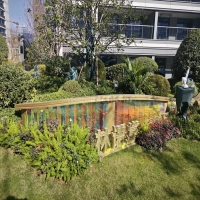Welcome to the website for landscape facilities products and knowledge.
What are the best amphibian habitat designs for cedar landscape sculpture?
Creating a thriving amphibian habitat within a cedar landscape sculpture requires a blend of aesthetics and functionality. Cedar, known for its durability and natural resistance to decay, is an excellent material for crafting sculptural elements that double as shelters for frogs, toads, and salamanders. Here are the top design ideas to harmonize art and ecology:
1. Multi-Level Cedar Ponds: Integrate shallow water features with cedar edges to provide hydration and breeding grounds. Amphibians thrive in ponds with gradual slopes and submerged logs for basking.
2. Cedar Hollow Logs: Stack or carve cedar logs to create hiding spots. These mimic natural forest debris, offering cool, damp retreats during hot days.
3. Moss-Covered Cedar Terraces: Plant moisture-retaining moss on cedar steps or platforms. This creates a microhabitat for amphibians while adding visual texture to the sculpture.
4. Shaded Cedar Canopies: Design elevated cedar structures with overhangs to provide shade and humidity, critical for amphibian survival.
5. Integrated Wetland Gardens: Surround cedar sculptures with native wetland plants like ferns and sedges to attract insects—ample food for amphibians.
By combining cedar’s rustic charm with eco-conscious design, your landscape sculpture can become a sanctuary for amphibians while enhancing your garden’s beauty. Keep water clean, avoid chemicals, and ensure year-round moisture for best results.
Related search:

Recommendation
Metal and acrylic color-changing combined curtain wall for large-scale public landscape facilities